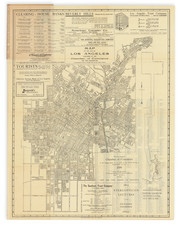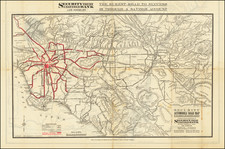Early Los Angeles Vineyards, The Zanja Madre and Early Survey of the Los Angeles River
Finely executed hand drawn map of a section of the Los Angeles River in Downtown Los Angeles, which also illustrates the "zonja" and waterwheel, and early reference to the Los Angelesa Zanja Madre.
The map shows the surveys of the Los Angeles River conducted by Adolphus Waldemar in November 1862, and is countersigned on January 5, 1863, by then Mayor Damien Marchesseault, who would also serve as Zanjero of Los Angeles (water steward), a position that was more important than Mayor at the time.
Historical Overview
The map illustrates the course of the Los Angeles River at the beginning of the 1860s. In 1858, Los Angeles was incorporated as a city. In 1861-62, The Great Flood of 1862 (50 inches of rain in 5 weeks) washed away the river banks and much of the city's existing water system. The present survey undertaken in 1862 by Adolphus Waldemar, was the first modern survey of the river.
Among the more fascinating elements of this map is the recording of the early landowners along the Los Angeles River, the vast majority of which were actively growing grapes and producing wine by the 1850s.
The map bears the note Los Angeles City Map No 23, referencing its inventory number in the official records of the City of Los Angeles. The map is in an identical hand to an example of the map in the Huntington Library. However the present map has significantly more detail, including a larg island in the river near El Aliso, as well a additional bridges and roads and land owners. As such, we believe this to be the surveyor's copy of the map, the original of which was deposited with the city.
The Map's Coverage
The map is centered on the Aliso Village Area, with First Street Bridge and a Bridge for the road to Mission San Gabriel, which would become Macy Street and later Cesar Chavez Avenue, with the road to El Monte just to the south (now the route of Highway 101 and Interstate 10)
At the top of the map, a Waterwheel appears. This shows the connection to the Zanja Madre (Mother Trench), the original aqueduct that brought water to the Pueblo de Los Angeles from the Río Porciúncula (Los Angeles River). The original open, earthen ditch was completed by community laborers within a month of founding the pueblo of Los Angeles in 1781.
Zanja Madre -- The First Water Source for the Pueblo of Los Angeles
The Zanja Madre was placed close to present-day Broadway at the foot of the Elysian Hills by the river. An earth and brush dam, called a toma, was created to pool up the water into the ditch which then ran along an elevated slope down to the pueblo after which it was split into multiple ditches which ran to the various portions of lowland. A large water wheel (40 foot diamater), constructed in the 1850s, raised the water up to the Zanja Madre and onto the main brick reservoir that was located in what is now the Plaza at the end of Olvera Street. The wheel was susceptible to damage from floods. The toma was washed away several times before a wooden one was built in its place, but was used unjtil the late 1870s and early 1880s.
The conversion from he zanja system for domestic water to an underground iron pipe water system began in 1867. Jean Louis Sansevain, a Frenchman who owned an extensive vineyard and winery on Aliso Street, was authorized by the City Council to lay 5,000 feet of iron pipe and to build a dam and reservoir. Discouraged by repeated failures, Sansevain the following year offered his lease to a group of individuals who formed a private corporation known as the Los Angeles Water Company.
The Vineyards of the Los Angeles River Basin
The names of the property owners along the river include a number of prominent citizens of Los Angeles, most of whom were engaged in growing grapes and producing wine. From North to South, these include:
- [Louis] Willhardt (sic): Louis Wilhardt was an early California tanner, vintner and grape grower. The Wilhardt family came to Southern California in the early 19th century and married into the Peralta family. Louis Wilhardt came west in 1847, settling in the Los Angeles area, where he became a successful vintner. The Wilhardt tract, divided in the 1880s, is shown here: https://www.raremaps.com/gallery/detail/34192
- Porter [Weixel?]
- Elijah Moldan (Moulton): Member of the Bridger Party, who arrived in LA in 1845 and owned land adjacent to William Wolfskill.
- Burdock
- [Stephen Clark ?] Foster: First Mayor of Los Angeles in 1854.
- B. Ramirez
- D. Sepulveda
- [William] Wolfskill: First arrived in Southern California with George C. Yount from New Mexico in 1831 to hunt otter. By 1866, he was producing 50,000 gallons of wine per year.
- Mrs. [Thomas] White: Thomas J. White, a physician from St. Louis, had settled in 1855. He had a 15-acre vineyard which had been planted in the 1840's and a younger vineyard of similar size.
- Pedro Sainsevain: French-born Californian vintner, ranchero, and a signer of the Californian Constitution in 1849. He is best known for his role in Californian winemaking, as one of the first producers of sparkling wine in California.
- F[rancisco] Temple: Partner and son-in-law of William Workman. One of the wealthiest men in Southern California until his demise in the 1870s.
- [Michael] Clement: French Winemaker who was producing wine by 1852 near the Los Angeles River.
- [Killian] Messer: German emigrant who arrived in 1854 and built a brewery at Third and Main Street and a vineyard extending along First Street between Alameda Street and the river.
- Lelong -- Probably Martin DeLong, , a Frenchman, who served in the American forces against Mexico in 1847 and owned a 14 acre winery.
- [Joseph] Huber: Arrived from Kentucky in 1855 and bought a property on Alameda Street extending from Second to Sixth Streets and east to the River. He had considerable success as a winemaker until his death in 1866..
- [Matthew] Keller: Irish born emigrant to Texas in the mid-1830s, who lived in Mexico before coming to Los Angeles in 1851. In 1852 he established his winery and brandy, the Rising Sun and Los Angeles Vineyards winery. As early as 1858, he had 12 varieties of grapes. He would go on to establish depots in San Francisco, Philadelphia and New York. Keller was called the "father of horticulture in Los Angeles," because, in 1853 he planted orange trees from seeds obtained in Central America and Hawaii.
- [Felipe?] Martinez
- Carrion
Rarity
We locate a similar copy with less detail at the Huntington Library: https://hdl.huntington.org/digital/collection/p15150coll4/id/12655









![[ Mapping an Historic Rainfall Event in Southern California ] Isohyetal Map of Northwestern Part of Southern California Showing total precipitation, in inches, February 27 to March 4, 1938](https://storage.googleapis.com/raremaps/img/small/82484.jpg)

![(Hollywood) [Annotated Real Estate Map of Hollywood]](https://storage.googleapis.com/raremaps/img/small/97362.jpg)
![Pasadena [with] Southern California](https://storage.googleapis.com/raremaps/img/small/99025.jpg)

![[ California Petroleum ] A Description of the Recently Discovered Petroleum Region in California. With a Report on the Same [with:] Map Representing Locality of The Ojai Ranch in Santa Barbara County, California, belonging to the California Petroleum Company 1865](https://storage.googleapis.com/raremaps/img/small/103844.jpg)